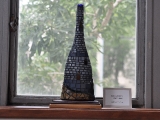John’s most recent artwork took over 7 kiln firings to accumulate the stones for the bridge and the trees. The gallery starts with just the outline of a bridge complete. You can see the fresh glue under some of the stones and the bushes, on both sides of the bridge. As the pictures proceed you see the painting emerge. First the bushes create distance and depth from the bridge, see what a difference the glue makes wet and then dry. The different shades of stone grant the illusino of shade and shadows on the side and under the bridge. A zoomed in photo on the bridge shows how unique each stone is; the effects of the kiln at different temperatures, on different colors of glass. The glass two trees in the forefront, the bush in the middle and the bridge were all the product of fusion. On the right side of the painting one can almost see the castle through the trees.
A few pictures of Raz ma taz are in this next gallery. A lot of time and work went undocumented in between these pictures. As the background is covered, the leaves and stems are engulfed. The flowers, stem, leaves, as well as part of the vase, were fused.
Eyes in the Sky was made in November/December 2013. The three eyes were heated to 1350°; this created a contact fuse rather than a full fuse, so you can see a ridge between the pupil and cornea. John added two additional pieces of wood on the canvas to create a layered effect, which ended up giving the eyes a distinct border. You can see how the glass becomes iridescent as the light hits in from an angle.
The following Landscape piece, Paradise, was made between March and April 2013. With some of the photographs taken of the canvas during the creation process, the viewer can get a sense of how the art takes shape. The pictures begin with the canvas a day into the project, after the fused orchid and salvia were glued and the majority of the tree is in place. The remaining photos capture the glass appearing in spurts; the islands, the beach, the sky.
And here is a short clip of John as he is filling in the background tree by cutting and grinding each piece.
Each concept is crafted one piece at a time; from wooden canvas, to the unique bordered frame, and each individually chipped piece of glass.
The wooden canvas is chosen depending on the size of the imagined picture.
In these pictures you can see JCC finishing covering the canvas; white and clear adhesive caulk is used depending on the color and transparency of the glass.
The flowers and vase in Vase on a Sill were created using a fusion technique in which you melt glass on top of glass inside a kiln at over (1300 Degrees)
This technique takes some time to learn, but once mastered it has a textured and three dimensional affect on the glass.






















































